By Mark Dean
Counting and Cracking, presented at the Edinburgh International Festival this summer, is a realistic, heartfelt, multigenerational, multinational family saga delivered in four languages, with 19 performers over three and a half hours. The hour-long Materia, written and performed by Andrea Salustri at the Edinburgh Fringe Festival, by contrast, is a highly conceptual, solo performer tour-de-force exploring polystyrene in sound and motion, with not a single word spoken. The first show offered unique insights into the depth of experiences driving immigrants across dangerous journeys to distant nations, while the second performance created wonder within the simple tactile discovery of an essential modern material, that during the performance was both elevated to poetic and heavenly heights, and also exploded—Icarus like—into eventual chaos and destruction. Both productions enlighten and transport audiences to a new awareness of the people and the world around us, though in radically different ways.
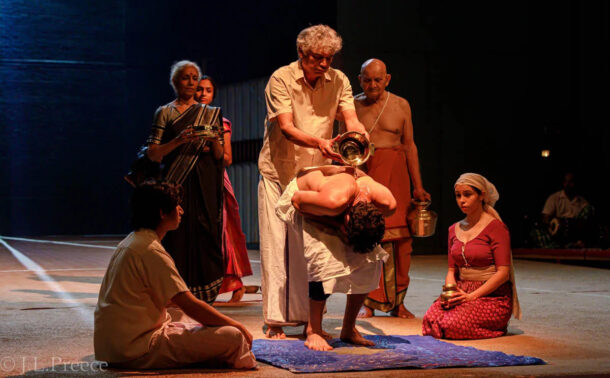
Counting and Cracking, written and performed by S. Shakthidharan. Photo: Edinburgh Festival.
Counting and Cracking, written and directed by the pair of artists S. Shakthidharan and Eamon Flack, originally for the Belvoir St Theatre Company in Sydney Australia in January of 2019, and seen on tour at the Edinburgh International Festival on August 13, 2022, is a cultural deep dive into the history of a Sri Lankan family over three generations, and their immigration to Australia following political upheavals in Sri Lanka from the 1970s through the early 2000s. It is performed in Sinhalese, Tamil, an Indigenous Australian dialect of Yolngu Matha, and English, and conveyed to the audience through supertitles and onstage interpreters, who take part in an active back-and-forth with the characters they interpret. Among the most powerful of the themes of the play, about Sinhalese becoming the official language of Sri Lanka (and excluding the minority Tamil language), is articulated succinctly by the family’s grandfather patriarch: “Two languages, one country, one language, two countries.” This syllogism encapsulates the profound cultural bonds that can come with diversity, and conversely, the internecine conflict that can arise when one ethnic group’s language is elevated while the others are suppressed for the political expediency of nationalistic “unity.”
The play opens with the Sri Lankan son Siddhartha, or Sid (played by Shiv Palekar, perfectly embodying his young adult cultural coming of age), who has become alienated from his heritage, being imposed upon by his domineering mother Rhada (played with an iron will by Nadie Kammallaweera, who exposes the pain of her journey by the play’s conclusion) to help in a ceremony to spread his recently deceased grandmother’s ashes into the waters of Sydney Harbor, a new incarnation of an ancient Sri Lankan tradition. This ceremony seems like it might close the historical chapter of this immigrant family’s life, and let them fully integrate into contemporary Australian life, as Sid would like to. However, an unexpected call comes from out of the blue, and Sid’s father Thirru, long thought killed in political upheavals around the time of Sid’s birth and the family’s escape to Australia, calls from an immigrant transition center seeking help obtaining asylum and wanting to know: should he—after all this time—come and join Rhada and Sid? The play continues—through flashbacks, flash-forwards, sideways and diagonal leaps—to movingly enact the non-traditional meeting of young Rhada and Thirru, alongside the internal Sri Lankan political fight (with Rhada’s father Apah on one side, giving voice to “two languages, one country”), to determine the destiny of the newly independent former British colony. Political conflict turns to violence that escalates over time and ensnares an unsuspecting Thirru, while the pregnant Rhada—believing after repeated searching that Thirru is dead—abandons Sri Lanka for the safety and promise of Australia. The performance moves seamlessly between the 1950s and 1970s Sri Lanka and present-day Australia, giving us nuanced connections to all members of the family as they progress on their journey, grow closer and farther apart, tragically disperse, and miraculously reconnect. By the closing image of the play, with the aged Thirru in the embrace of a fully mature Rhada, Sid, and even Sid’s Aboriginal girlfriend Lily, we have been through an epic saga with them, and feel the warmth, and necessity of their mutual embrace.
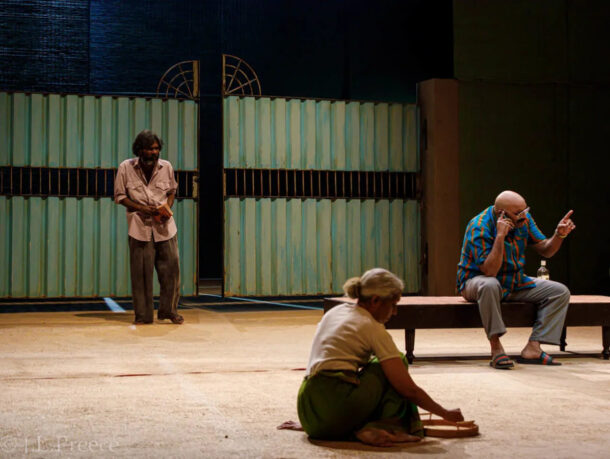
Counting and Cracking, written and performed by S. Shakthidharan. Photo: Edinburgh Festival.
Counting and Cracking’s staging is wonderfully fluid and suggestive, allowing the 16 actors and 3 musicians to wander across the globe and through time seamlessly. Their journey invites the audience to grow alongside this Sri Lankan family, through its celebrations and crises over the decades. The costumes beautifully reflect traditional Sir Lankan dress, as well as inevitable transitions to modernity. Most compelling was the decision for many Sri Lankan scenes to be spoken in Sinhalese and Tamil, and translated in real time by onstage interpreters, who interacted with their character counterparts. Within the scripted story, the characters are given theatrical license more than once to turn to their interpreters, and correct mistranslations, to which the translators graciously and even humorously, make adjustments. This simple device helped illustrate in real time the difficulties of sharing meaning across languages and cultures, and also modeled kindness, collaboration, and the give and take required to create trust and community across cultures.
The history and current events of Sri Lanka’s connection to Australia are complex. According to many, including Indrajit Samarajiva’s 15 August 2022 New York Times Op-Ed, the ongoing civil unrest in Sri Lanka is compounded by the pandemic-induced collapse of what was already a teetering economy. In Sri Lanka currently, graft is endemic, President Gotabaya Rajapaksa was forced to flee the country in July of 2022, and the current inflation rate is between 60 and 90 percent. On 15 August 2022, Ben Doherty reported in the Guardian that poor Sri Lankans are desperately fleeing the country on rickety, dangerous boats for the economic promise of life in Australia, and being turned back at sea by Australian authorities. Along with many other so-called “first world” countries, Australia is vigorously turning back very poor Sri Lankan refugees, going so far as to process refugee claims for political asylum at sea, to expedite the process of returning the boats and their occupants to Sri Lanka. Activists question the legality of at-sea asylum processing, just as US activists protest and question whether the United States can or should turn back Central American refugees seeking asylum, to await their claims processing in Mexico.
From a political perspective, Counting and Cracking’s focus on one family’s long-term connections to Australia, clearly presenting the story of specific political asylum seekers, made an effective and emotional case for Australia to continue—and even enlarge—its humanitarian acceptance of Sri Lankan refugees. This particular story did not address the complexity of Sri Lanka’s current economic plight, driven by international economic forces and historical injustices, relating to the history of physical and economic European colonization. It may take another production to delve into those intractable questions, as a single theatre piece can accomplish only so much. Counting and Cracking sheds enormous light on one corner of the Australian immigrant community and helps us all look at news coming from Australia about its immigrant policies and populations very differently.
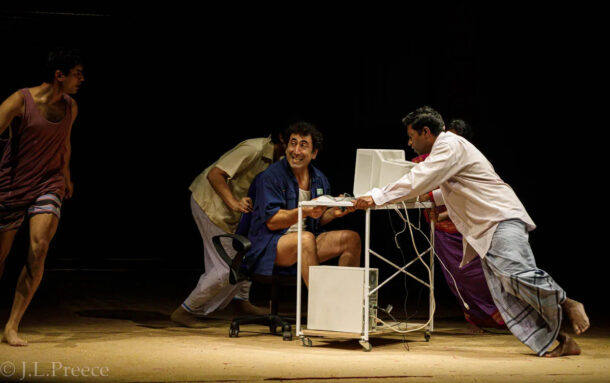
Counting and Cracking, written and performed by S. Shakthidharan. Photo: Edinburgh Festival.
While Counting and Cracking is specific to real-world people and events, Andrea Salustri’s solo performance in Materia, presented by Aurora Nova and seen at the Edinburgh Fringe Festival on 9 August 2022, lacks any words or narrative per se, and consists only of the performer and his polystyrene sheets and spheres in evolving relationship to each other, both harmonious and volatile. The Latin noun materia indicates an undefined substance from which the universe was assembled. This definition perfectly fits the experience of Salustri’s entirely wordless performance, as he explores, at first gently and in delicate balance, and then in a manner that is increasingly out of control, visceral, and cacophonous, the physical, visual, and aural possibilities of the various Styrofoam sheets, spheres, and detritus he has brought to the space to examine, explore, and create a relationship with.
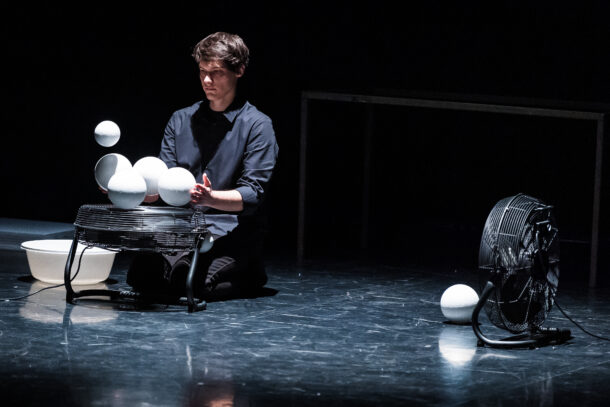
Materia, written and performed by Andrea Salustri. Photo: Edinburgh Festival.
In the demure opening of Materia, Salustri experiments with a fan and polystyrene balls, gently floating one, and then multiple balls at once, and then on to sheets of thin polystyrene, also floating between fans, as he explores the properties that exist between the material and the created wind, as the polystyrene slowly begins to rise and take on a tentative life of its own. Salustri and Materia exemplify the strengths of non-verbal theatre, transcending narrative plot and giving voice to our deep fascinations with the world around us, what it is made of, how we can bend and control those elements, and, finally, how we go too far, without ever necessarily meaning to. Salustri’s inquiry into polystyrene is captivating—the performance is so non-verbal as to be dramatically so—ironically pushing us at times to the limit of our interest and patience. Salustri’s own curiosity and patience with his task is exemplary, though, and so slowly does the polystyrene transformation take place, that the audience risks becoming disengaged. Salustri continues to experiment, however, and the polystyrene begins to transform and evolve, and it occurs to me as I watch and begin to get drawn into the intense silence that this discovery process is interesting, simply for its own sake, that words are not needed, a narrative plot is not needed, the exploration, discovery, and growth of this polystyrene world is its own purpose and reward. At one point, when Salustri has discovered how to float a polystyrene sheet in air, the event viscerally evoked for me Wilber and Orville Wright’s ingenious experiments deciphering how to harness the wind for human flight, which required them to stare at birds for long periods of time to discover how birds’ wings controlled the air that lifted them. I imagine those two bicycle mechanics coming to their task with a similar childlike curiosity that Salustri has, and discovering similar levels of profound union with the worldly yet ethereal element of his experimentation.
Salustri’s love affair with polystyrene eventually blends into a dance with the lightweight sheet in a way that shows the polystyrene coming into a life of its own, partnering and leading Salustri, rather than simply Salustri manipulating it—a partnership of apparent equals has arisen with the materials. Salustri has thus become something of a co-creator of the universe around him, by breathing life into the inanimate object of his desire. That Salustri is clothed all in black, while his materia is all white, further evokes the Yin-Yang, opposites that Saulstri and the polystyrene start from, before they begin to merge together as equal partners. Salustri proceeds from there to warp the polystyrene panel with a heat gun, breaking through it with his hands and fingers (which also take on a life of their own, in an elaborate and brittle field of polystyrene, a little universe unto itself), before he destroys the polystyrene universe he has created and explored, in a liquid solution that completely dissolves the physical substance itself. That could be the end of the show, but instead only serves as a springboard for Salustri to create an even larger universe of various forms of polystyrene. In combination with microphones, sound and light, cascading across multiple points on the stage, in and among itself, there comes a veritable “storm on the heath,” an out-of-control cacophony of sound, light, and polystyrene, large, small, round, triangular, and dust-storm sized. This chaotic maelstrom finally resolves itself into silence, dust, a newly un-formed-ness, evocative of the progress of climate change through human-created curiosity and hubris, and the inevitable destruction required to wipe away too much human interference, so that for creation might be able to begin again.
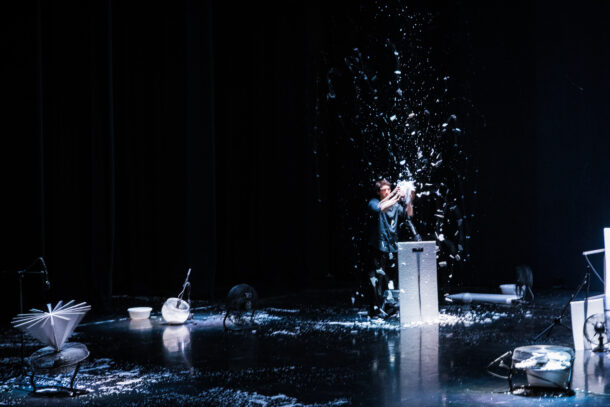
Materia, written and performed by Andrea Salustri. Photo: Edinburgh Festival.
The entire piece involves Salustri evolving in relationship with the materia, leading it and following it so that the powerful images that grow organically, seemingly uncontrived by Salustri himself. The quiet, mini scale of most of the effects lend themselves to an intimacy, and to the feeling that all is benign, that even when the materia grows beyond the size and scope Salustri may have imagined, it always seems that he brings it back under control. Such a simplified, intimate setting, with the interaction of sound, light, and dynamic movement, creates what can be felt as a story of creation, from the dawn of the universe. That we arrive at sound and light, full stage cacophony of an end-of-times image comes at us by surprise: the logical conclusion of our persistent curiosity that nevertheless seems to have a mind of its own, a force bigger than Salustri, or all of us, gathered to watch the end come. When all the images do shatter into silence, we are left with pure loss, surprising in how attached we have inadvertently become to this material. That Materia and Salustri do all this with no text is remarkable, enacting a brilliant silent show version of the timeless story of Marlowe’s Dr. Faustus, in a performance so strong in image and visceral engagement that words would only diminish it. Words unavoidably interpret, and thereby limit experience. In dispensing with words in favor of an engaged universe in action and motion, Materia gives us generative art that rises above language, returning us to preverbal, ancient and primordial experience.
Counting and Cracking explores in exquisite detail one relatively small segment of our human history over three generations, compelling us empathically to follow and care for a migrant family trying to come to terms with a past they cannot outrun. Materia, by contrast, begins at the initial act of discovery, and it is the unexpected and uncontrolled future that takes us, and the performer by surprise. Counting and Cracking gives us a fully human, resonant experience of specific people at a moment in time, while Materia gives us one possible evocative beginning, journey, and end to the impossibly large question of our existence, and our place in the world. The first production gives us a shared experience of a family integrating their difficult past, while the second awakens us to the dangers of too blithely assuming that we are necessarily the masters of our future. Both theatre pieces leave us contemplating where we have been, and what surprises might be up around the next corner.
Mark Dean is an actor, director, theatre administrator, husband, and father in Northampton, Massachusetts. He holds an M.F.A. in Directing from the Mason Gross School for the Arts at Rutgers University and has been an adjunct lecturer at the University of Massachusetts at Amherst.

European Stages, vol. 17, no. 1 (Fall 2022)
Editorial Board:
Marvin Carlson, Senior Editor, Founder
Krystyna Illakowicz, Co-Editor
Dominika Laster, Co-Editor
Kalina Stefanova, Co-Editor
Editorial Staff:
Asya Gorovits, Assistant Managing Editor
Zhixuan Zhu, Assistant Managing Editor
Advisory Board:
Joshua Abrams
Christopher Balme
Maria Delgado
Allen Kuharsky
Bryce Lease
Jennifer Parker-Starbuck
Magda Romańska
Laurence Senelick
Daniele Vianello
Phyllis Zatlin
Table of Contents:
- AVIGNON 76. A Festival of New Works by Philippa Wehle
- Almodóvar’s Women on the Verge in Portugal by Duncan Wheeler
- BRACK IMPERie. About “Hedda Gabler” by Vinge/Müller at Norske Teatret Oslo by Thomas Oberender
- Embodied Intimacy: The Immersive Performance of The Smile Off Your Face at Edinburgh by Julia Storch
- Fear, Love, and Despair – Radu Afrim: Director of Core Feelings by Alina Epîngeac
- Grec Festival de Barcelona, July 22 by Anton Pujol
- I Think of Curatorial Work in Scholarly Terms: An Interview with Ivan Medenica by Ognjen Obradović
- New Worlds Revealed in an Immigrant Journey, and an Unexpectedly Meaningful Universe Discovered and Destroyed Inside Styrofoam, at the Edinburgh Festival by Mark Dean
- Participation, Documentary and Adaptation: Barcelona Theatre May 2022 by Maria Delgado
- Report from Berlin, April 2022 by Marvin Carlson
- Report from Berlin (and Hamburg….) 5/2022 by Philip Wiles
- The Sibiu International Theatre Festival Transforms Dreams into Reality (The Magic of 2022 FITS in Short Superlative) by Ionica Pascanu
- Theatre in Denmark and The Faroe Islands – Spring 2022 by Steve Earnest
- The Polish Nation in a Never-Landing Aircraft by Katarzyna Biela
- The Piatra-Neamt Theatre Festival in Romania: 146 Kilometers from Heart to Heart by Cristina Modreanu
- Will’s Way at the Shakespeare International Festival Craiova 2022 by Alina Epîngeac
- Interview with the Turkish theatre critic Handan Salta on TheatreIST by Verity Healey
www.EuropeanStages.org
europeanstages@gc.cuny.edu
Martin E. Segal Theatre Center:
Frank Hentschker, Executive Director
Marvin Carlson, Director of Publications
©2022 by Martin E. Segal Theatre Center
The Graduate Center CUNY Graduate Center
365 Fifth Avenue
New York NY 10016
European Stages is a publication of the Martin E. Segal Theatre Center ©2022


